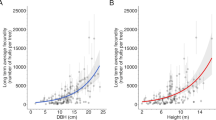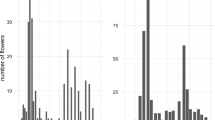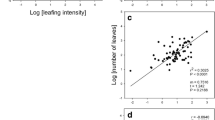Abstract
We monitored the reproductive status of all trees with diameters at breast height (dbh) >30 cm in a 40-ha plot at Pasoh, west Malaysia, and investigated the individual fecundity of 15 Shorea acuminata Dyer (Dipterocarpaceae) trees using seed-trapping methods during two consecutive general flowering periods in 2001 (GF2001) and 2002 (GF2002). The proportion of flowering trees was higher, and not dependent on size, in GF2002 (84.2%), than in GF2001 (54.5%), when flowering mainly occurred in trees with a dbh ≤70 cm. Fecundity parameters of individual trees per event varied widely (221,000–35,200,000 flowers, 0–139,000 mature seeds, and 1.04–177 kg total dry matter mass of fruit (TDM) per tree). Monotonic increases with increasing tree size were observed for flower production and TDM amongst trees up to 90 cm in dbh, but not for mature seed production or for any of these parameters amongst larger trees. The pattern of reproductive investment during the two consecutive reproductive events clearly differed between medium-sized and large trees; the former concentrated their reproductive investment in one of the reproductive events whereas the latter allocated their investment more evenly to both reproductive events. Our results suggest size-related differences in the resource allocation pattern for reproduction.



Similar content being viewed by others
References
Alvarez-Buylla ER, Martinez-Ramos M (1992) Demography and allometry of Cecropia obtusifolia, a neotropical pioneer tree-an evaluation of the climax-pioneer paradigm for tropical rain forests. J Ecol 80:275–290
Appanah S (1979) The ecology of insect pollination of some Malaysian rain forest trees. Doctoral thesis. University of Malaya, Kuala Lumpur
Appanah S (1985) General flowering in the climax rain forests of South–East Asia. J Trop Ecol 1:225–240
Appanah S, Chan HT (1981) Thrips: the pollinators of some dipterocarps. Malays For 44:234–252
Appanah S, Manaf MRA (1990) Smaller trees can fruit in logged dipterocarp forests. J Trop For Sci 3:80–87
Ashton PS (1982) Dipterocarpaceae. Flora Malesiana, series 1, vol 9, Martinus Nijhoff Publishers, The Hague
Ashton PS (1989) Dipterocarp reproductive biology. In: Lieth H, Werger MJA (eds) Tropical rain forest ecosystems. Elsevier, The Netherlands, pp 219–240
Ashton PS, Givinish TJ, Appanah S (1988) Staggered flowering in the Dipterocarpaceae: new insights into floral induction and the evolution of mast fruiting in the aseasonal tropics. Am Nat 132:44–66
Burgess PFS (1972) Studies on the regeneration of the hill forests of the Malay Peninsula. Malays For 35:103–123
Chan HT (1980) Reproductive biology of some Malaysian dipterocarps II. Fruiting biology and seedling studies. Malays For 43:438–451
Chan HT, Appanah S (1980) Reproductive biology of some Malaysian dipterocarps I. Flowering biology. Malays For 43:132–143
Curran LM, Leighton M (2000) Vertebrate responses to spatiotemporal variation in seed production of mast-fruiting dipterocarpaceae. Ecol Monogr 70:101–128
Ghazoul J, Liston KA, Boyle TJB (1998) Disturbance-induced density-dependent seed set in Shorea siamensis (Dipterocarpaceae), a tropical forest tree. J Ecol 86:462–473
Greene DF, Johnson EA (1989) A model of wind dispersal of winged or plumed seeds. Ecology 70:339–347
Greene DF, Johnson EA (1994) Estimating the mean annual seed production of trees. Ecology 75:642–647
Harper JL, White J (1974) The demography of plants. Annu Rev Ecol Syst 5:419–463
Hirayama D (2005) Individual, interspecific, and annual variations in female reproductive variables in trees. Doctoral thesis. Osaka City University, Osaka
Hirayama D, Itoh A, Yamakura T (2004) Implications from seed traps for reproductive success, allocation and cost in a tall tree species Lindera erythrocarpa. Plant Species Biol 19:185–196
Ichie T, Kenzo T, Kitahashi Y, Koike T, Nakashizuka T (2005) How does Dryobalanops aromatica supply carbohydrate resources for reproduction in a masting year? Trees 19:703–710
Itoh A, Rokujo N, Kanzaki M, Yamakura T, Lafrankie JV, Ashton PS, Lee HS (2004) An approach for assessing species-specific density-dependent and habitat effects on recruitment of a tropical rainforest tree. In: Losos EC, Leigh EG (eds) Tropical forest diversity and dynamism: findings from a large-scale network forest dynamics plots. The University of Chicago Press, Chicago, pp 320–339
Janzen DH (1971) Seed predation by animals. Annu Rev Ecol Syst 2:465–492
Maycock CR, Thewlis RN, Ghazoul J, Nilus R, Burslem DFRP (2005) Reproduction of dipterocarps during low intensity masting events in a Bornean rain forest. J Veg Sci 16:635–646
Momose K, Nagamitsu T, Inoue T (1996) The reproductive ecology of an emergent dipterocarp in a lowland rain forest in Sarawak. Plant Species Biol 11:189–198
Naito Y, Konuma A, Iwata H, Suyama Y, Seiwa K, Okuda T, Lee SL, Norwati M, Tsumura Y (2005) Selfing and inbreeding depression in seeds and seedlings of Neobalanocarpus heimii (Dipterocarpaceae). J Plant Res 118:423–430
Nakagawa M, Takeuchi Y, Kenta T, Nakashizuka T (2005) Predispersal seed predation by insects vs. vertebrates in six dipterocarp species in Sarawak, Malaysia. Biotropica 37:389–396
Nathan R, Muller-Landau HC (2000) Spatial patterns of seed dispersal, their determinants and consequences for recruitment. Trends Ecol Evol 15:278–285
Ng FSP (1977) Gregarious flowering of Dipterocarps in Kepong, 1976. Malays For 40:126–137
Niiyama K, Kassim AR, Iida S, Kimura K, Azizi R, Appanah S (2003) Regeneration of a clear-cut plot in a lowland dipterocarp forest in Pasoh Forest Reserve, Peninsular Malaysia. In: Okuda T, Manokaran N, Matsumoto Y, Niiyama K, Thomas SC, Ashton PS (eds) Pasoh: Ecology of a Lowland Rain Forest in Southeast Asia. Springer, Tokyo, pp 559–568
Norton DA, Kelly D (1988) Mast seeding over 33 years by Dacrydium cupressinum Lamb. (rimu) (Podocarpaceae) in New Zealand: the importance of economies of scale. Funct Ecol 2:399–408
Numata S, Yasuda M, Okuda T, Kachi N, Nur Supardi M (2003) Temporal and spatial patterns of mass flowerings on the Malay Peninsula. Am J Bot 90:1025–1031
Obeso JR (2002) The costs of reproduction in plants. New Phytol 155:321–348
R Development Core Team (2006) R: a language and environment for statistical computing. R Foundation for Statistical Computing, Vienna, Austria, ISBN 3-900051-07-0, URL: http://www.R-project.org
Sakai S (2000) Plant reproductive phenology in tropical forests—implications of general flowering in a lowland dipterocarp forest. Japanese J Ecol 50:23–29
Sakai S (2001) Phenological diversity in tropical forests. Popul Ecol 43:77–86
Sakai S (2002) General flowering in lowland mixed dipterocarp forests of South-east Asia. Biol J Linn Soc Lond 75:233–247
Sakai S, Harrison RD, Momose K, Kuraji K, Nagamasu H, Yasunari T, Chong L, Nakashizuka T (2006) Irregular droughts trigger mass flowering in aseasonal tropical forests in Asia. Am J Bot 93:1134–1139
Sakai S, Momose K, Yumoto T, Nagamitsu T, Nagamasu H, Hamid AA, Nakashizuka T (1999) Plant reproductive phenology over four years including an episode of general flowering in a lowland dipterocarp forest, Sarawak, Malaysia. Am J Bot 86:1414–1436
Samson DA, Werk KS (1986) Size-dependent effects in the analysis of reproductive effort in plants. Am Nat 127:667–680
SAS (2000) JMP user’s guide, version 4.0 of JMP. SAS Institute, Cary
Shibata M, Tanaka H (2002) Reproductive traits of trees in OFR. In: Nakashizuka T, Matsumoto Y (eds) Diversity and interaction in a temperate forest community: Ogawa Forest Reserve of Japan. Springer, Tokyo, pp 95–108
Shipley B, Dion J (1992) The allometry of seed production in herbaceous angiosperms. Am Nat 139:467–483
Soehartono T, Newton AC (2001) Reproductive ecology of Aquilaria spp. in Indonesia. For Ecol Manage 152:59–71
SPSS Inc. (2000) SPSS10.0. SPSS, Inc
Thomas SC (1996a) Reproductive allometry in Malaysian rain forest trees: biomechanics versus optimal allocation. Evol Ecol 10:517–530
Thomas SC (1996b) Relative size at onset of maturity in rain forest trees: a comparative analysis of 37 Malaysian species. OIKOS 76:145–154
Thomas SC, Appanah S (1995) On the statistical analysis of reproductive size thresholds in dipterocarp forests. J Trop For Sci 7:412–418
Wesselingh RA, Klinkhamer PGL, De Jong TJ, Boorman LA (1997) Threshold size for flowering in different habitats: effects of size-dependent growth and survival. Ecology 78:2118–2132
Whitmore TC (1984) Tropical rainforests of the Far East, 2nd edn. Oxford University Press, Oxford
Wright SJ, Jaramillo MA, Pavon J, Condit R, Hubbel SP, Foster RB (2005) Reproductive size thresholds in tropical trees: variation among individuals, species and forests. J Trop Ecol 21:307–315
Yap SK, Chan HT (1990) Phenological behaviour of some Shorea species in Peninsular Malaysia. In: Bawa KS, Hadley M (eds) Reproductive ecology of tropical forest plants. UNESCO and The Parthenon Publishing Group, Paris, pp 21–35
Yasuda M, Matsumoto J, Osada N, Ichikawa S, Kachi N, Tani M, Okuda T, Furukawa A, Nik AR, Manokaran N (1999) The mechanism of general flowering in Dipterocarpaceae in the Malay Peninsula. J Trop Ecol 15:437–449
Acknowledgments
The authors would like to thank Dr K. Niiyama for permission to use his 6-ha plot (plot 1), Dr A. Itoh for providing his unpublished manuscript, and Dr M. Yasuda for many advisory comments about this study. We also thank Mr A. Hussein and Mr A. Nyak for their assistance during this study, and all local staff of this project who helped us greatly in the field. This study was a part of a joint research project of FRIM, Universiti Putera Malaysia, and the National Institute for Environmental Studies of Japan (Global Environment Research Program supported by the Ministry of Environment in Japan, Grant No. E-4).
Author information
Authors and Affiliations
Corresponding author
Electronic supplementary material
Below is the link to the electronic supplementary material.
Appendix
Appendix
Table 2
Rights and permissions
About this article
Cite this article
Naito, Y., Kanzaki, M., Numata, S. et al. Size-related flowering and fecundity in the tropical canopy tree species, Shorea acuminata (Dipterocarpaceae) during two consecutive general flowerings. J Plant Res 121, 33–42 (2008). https://doi.org/10.1007/s10265-007-0116-x
Received:
Accepted:
Published:
Issue Date:
DOI: https://doi.org/10.1007/s10265-007-0116-x




